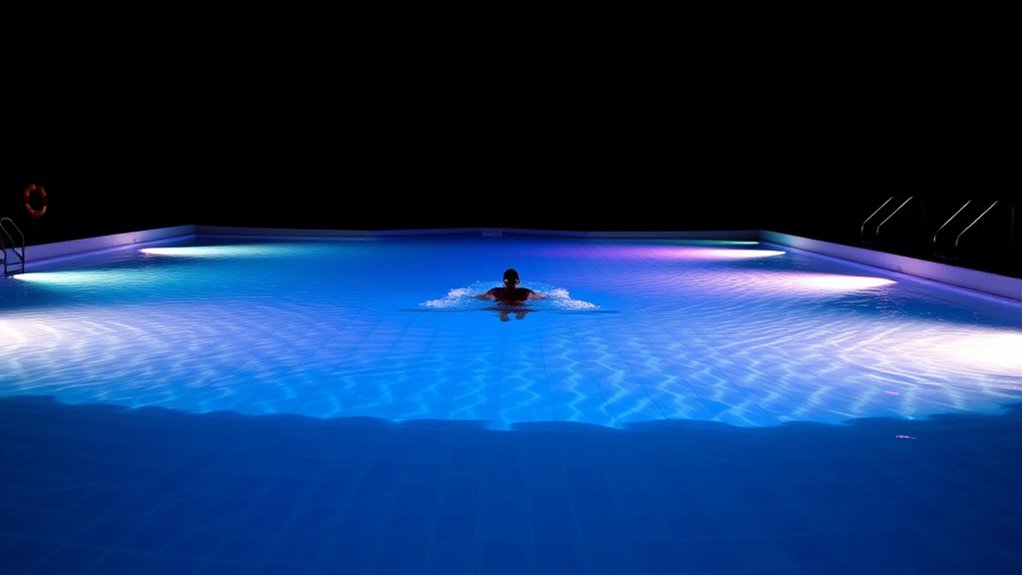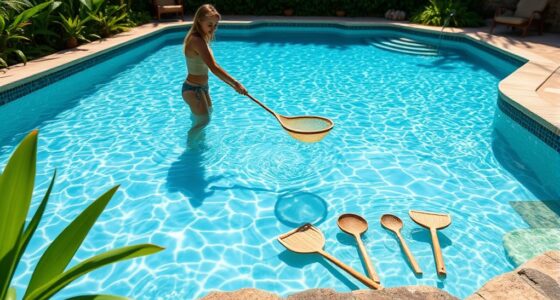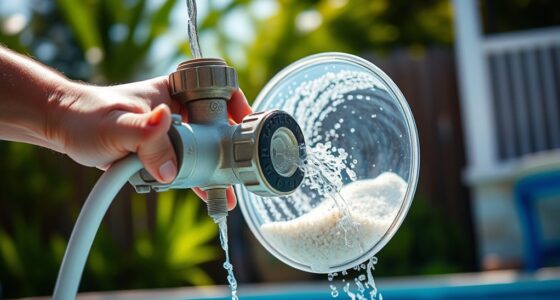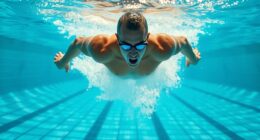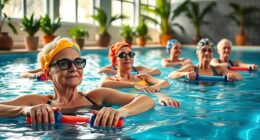For safe night swimming, choose waterproof, properly rated lighting fixtures that provide bright, even illumination around your pool or area. Place lights along pathways, stairs, and the pool edge to eliminate shadows and hazards. Use safety signage and markers to clearly indicate shallow and deep ends. Regularly check and maintain your lighting system to guarantee everything works correctly. Implement a swim buddy system and stay aware of environmental risks—if you keep exploring, you’ll discover more tips to stay safe.
Key Takeaways
- Use waterproof, properly placed lighting with appropriate color temperature to ensure visibility and safety around the pool area.
- Ensure all lighting systems are regularly maintained, inspected, and positioned to minimize shadows and enhance underwater clarity.
- Incorporate clear safety signage, waterproof markers, and illuminated hazards to alert swimmers of shallow, deep, or dangerous zones.
- Never swim alone; establish a swim buddy system and keep emergency supplies and communication devices nearby.
- Familiarize yourself with the environment and potential hazards to plan safety measures and respond effectively in emergencies.
Choosing the Right Lighting Equipment
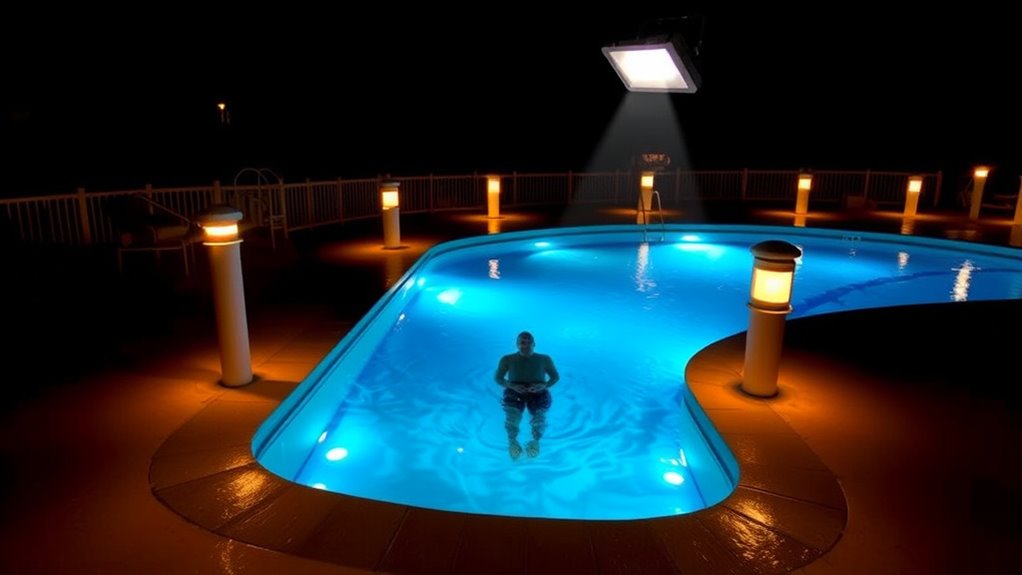
When swimming at night, selecting the right lighting equipment is essential for safety and visibility. You should prioritize waterproof fixtures that can withstand water exposure and harsh conditions. These fixtures ensure durability and prevent electrical hazards. Consider the color temperature of your lighting; warmer tones create a relaxing ambiance, while cooler tones enhance visibility. Bright, white lights with a higher color temperature help you see clearly underwater, reducing accidents. Look for fixtures specifically designed for aquatic environments, which are often sealed and rated for submersion. Choosing high-quality, waterproof lights with appropriate color temperatures guarantees you enjoy safe, well-lit swimming experiences after sunset. Proper selection of lighting equipment is the foundation for a safe and enjoyable night swim. Additionally, implementing AI safety measures can help monitor and maintain optimal lighting conditions in aquatic environments, ensuring ongoing safety during night swims. Incorporating the right lighting not only improves visibility but also enhances the overall swimming experience and safety. Understanding the importance of color accuracy in lighting choices can further improve underwater visibility and safety. To ensure consistent illumination, it’s also helpful to use durable waterproof connectors that prevent corrosion and maintain electrical integrity over time.
Proper Placement of Lights Around the Pool or Swimming Area
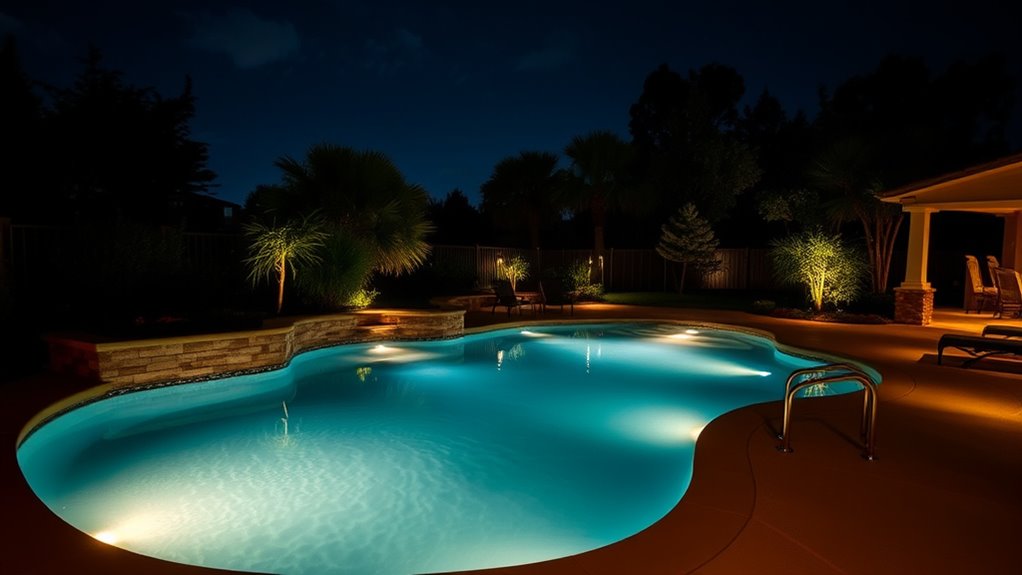
Proper placement of lights around your pool is crucial for ensuring safety and ideal visibility. Position decorative lighting along pathways, stairs, and the pool’s perimeter to illuminate potential hazards without causing glare. Use energy-efficient bulbs in fixtures to save power and reduce costs, while still providing sufficient brightness. Avoid placing lights directly in the water, as this can create glare and safety issues. Focus on highlighting key areas like entry points, shallow and deep ends, and any steps or ladders. Spreading lights evenly around the pool’s edge ensures a balanced glow and reduces shadows that could obscure obstacles. Proper placement not only enhances safety but also creates an inviting atmosphere for nighttime swimming. Maintain lighting performance by regularly inspecting and cleaning fixtures to ensure consistent brightness. Incorporating home decor & design principles, such as color coordination and fixture styles, can further enhance the overall aesthetic. Proper placement of lighting also involves understanding Juice Cleanse and Detox principles to avoid over-illumination, which can cause glare and reduce visibility. Additionally, understanding AI in Education advancements can inspire innovative lighting solutions that adapt to user needs. Keep visibility clear and lighting well-distributed for an enjoyable, safe experience.
Ensuring Adequate Visibility for All Swimmers

To guarantee all swimmers can see clearly and stay safe, you need to create a well-lit environment that minimizes shadows and dark spots. Proper lighting ensures everyone can navigate safely, especially during poolside entertainment. Use bright, even lighting around the pool area and avoid harsh glare that can impair vision. Keep water temperature monitoring in check so swimmers stay comfortable and alert, preventing accidents caused by hypothermia or overheating. Clear lighting also helps spot any potential hazards early, such as floating debris or swimmers in distress. When the pool is well-lit, swimmers can enjoy the night without worry, and lifeguards can monitor activity effectively. Consistent lighting and water temperature checks are essential for a safe and enjoyable night swimming experience. Additionally, understanding bad lemon juice signs can help ensure safe consumption of beverages before swimming. Incorporating adequate lighting options, such as LED floodlights or underwater lights, can further enhance visibility and safety.
Incorporating Safety Signage and Markers
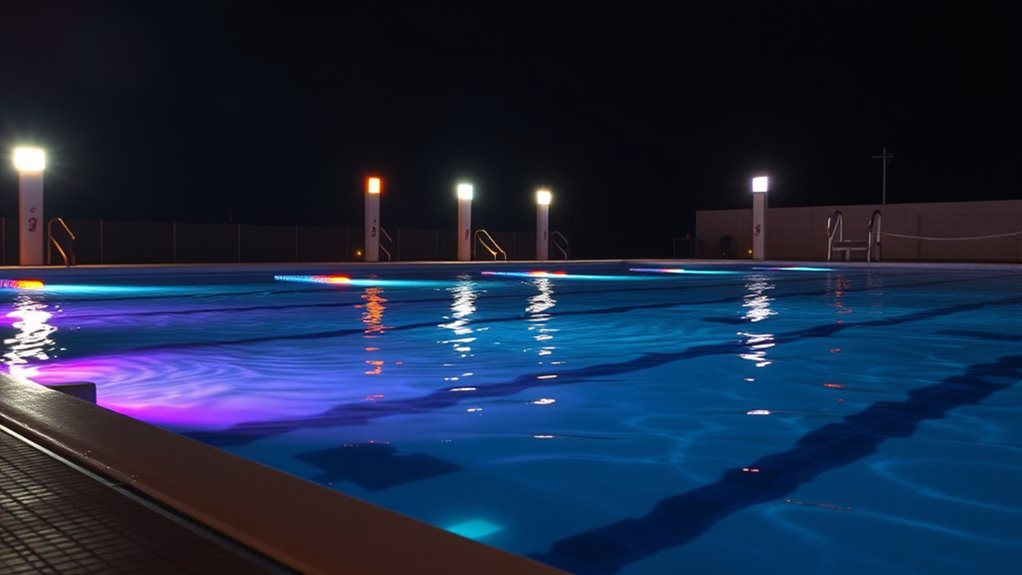
Clear signage and visible markers play a vital role in maintaining safety during night swimming. Proper poolside decor, such as brightly colored signs indicating shallow and deep ends, helps swimmers stay aware of their surroundings. Use waterproof markers or floating buoys to outline safe zones and hazard areas clearly. Underwater illumination not only enhances visibility but also highlights these markers, making them easy to see even in low light. Incorporate reflective surfaces or glow-in-the-dark signs to guarantee visibility from a distance. Consistent placement of signage at key points around the pool helps prevent accidents and guides swimmers safely. Regularly assessing and rotating items, as suggested in home organization, can also ensure that safety signage remains prominent and effective. Additionally, integrating mental wellbeing principles by promoting a calm and focused environment can further minimize risks during nighttime swimming. Ensuring that all safety measures comply with regulatory standards is essential to provide a secure swimming environment. Proper training and awareness about emergency response procedures should also be part of safety planning. Familiarity with feature Buddies can aid in maintaining a comprehensive safety setup. By combining effective signage with well-placed markers and underwater lighting, you create a safer environment that minimizes risks during nighttime swimming.
Maintaining and Checking Lighting Systems Regularly
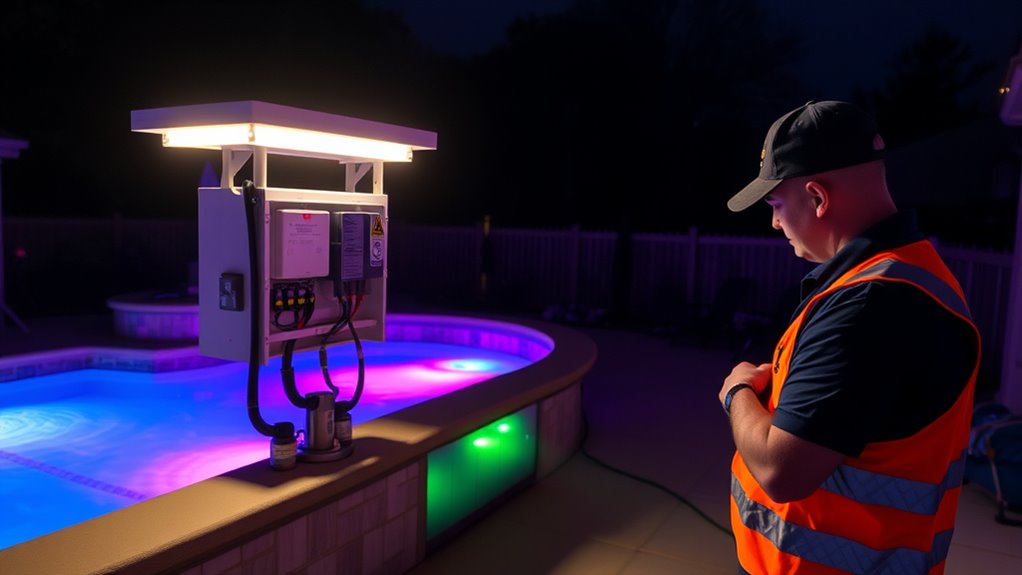
Regularly maintaining and checking your lighting systems is essential to guarantee they function properly and provide adequate visibility during night swimming. Consistent lighting maintenance helps identify potential issues before they become safety hazards. This proactive approach reduces the risk of malfunction and improves overall safety. Additionally, understanding the industrial juice manufacturing process can inspire you to adopt systematic checks similar to production standards for your lighting systems. Incorporating routine maintenance practices can further prolong the lifespan of your fixtures and ensure consistent performance. For example, adopting preventive maintenance strategies from manufacturing can help detect issues early and avoid costly repairs. Regular inspection of electrical connections and components, similar to the filter replacement guidelines used in air purifiers, ensures that all parts are functioning optimally. Incorporating rustic lighting fixtures can also enhance the aesthetic while being easier to maintain in outdoor or humid environments.
Additional Safety Precautions for Night Swimming
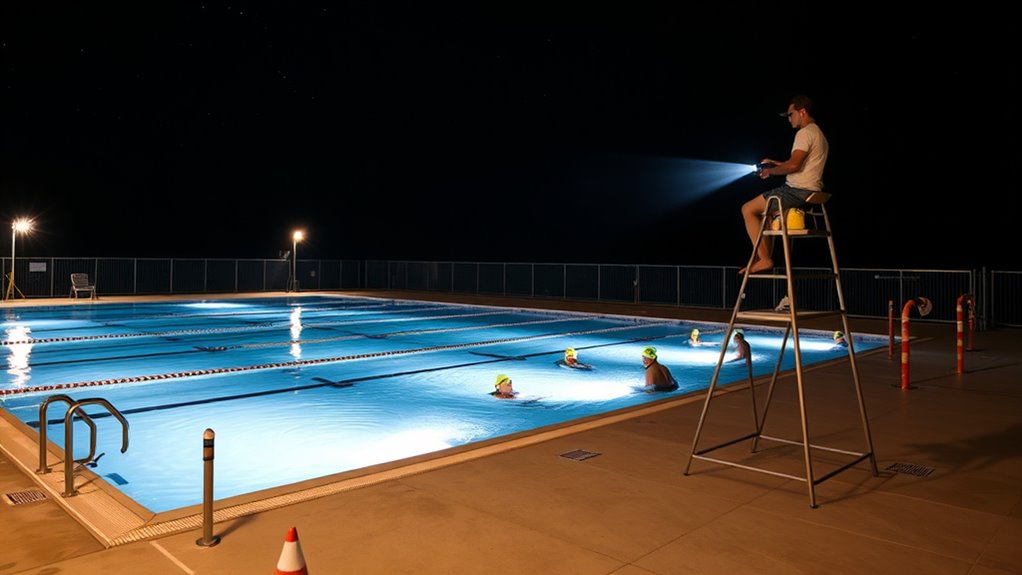
Ensuring your lighting systems are in top condition is a vital step, but it’s equally important to adopt additional safety measures before night swimming. First, prioritize emergency preparedness by having a fully stocked first aid kit nearby and knowing how to respond to accidents. Always use the swim buddy system—never swim alone at night—so someone is there to help if needed. Make sure your phone is accessible and charged for quick emergency contact. Set clear boundaries and establish a check-in plan with your buddy. These precautions minimize risks and guarantee you’re ready for unexpected situations. Be aware of emergency preparedness that can help you stay calm in emergencies, which may include techniques for stress management and quick decision-making, and plan your safety measures accordingly. Additionally, understanding financial transaction practices can help you manage unexpected expenses that arise during outdoor activities. To further enhance safety, familiarize yourself with knowing the environment, such as the water conditions and local hazards, before entering the water. By combining proper lighting, emergency readiness, and the swim buddy system, you greatly enhance your safety during night swimming.
Frequently Asked Questions
How Can I Prevent Accidental Electrical Shocks From Pool Lighting?
To prevent accidental electrical shocks from pool lighting, you should always prioritize electrical safety and proper lighting maintenance. Make certain that all electrical components are installed by a professional, regularly inspect for damage, and keep connections dry and secure. Turn off power before servicing the lights, and use Ground Fault Circuit Interrupters (GFCIs) for added protection. These steps help minimize risks and keep your night swimming safe and enjoyable.
What Are the Best Emergency Procedures for Night Swimming Incidents?
You should always be prepared with emergency response plans and first aid procedures in case of night swimming incidents. Verify that everyone knows how to call for help and perform CPR if needed. Keep rescue equipment nearby and make sure a phone is accessible for emergency calls. Regularly practice safety drills with swimmers, so you’re confident in your response. Quick, calm action can save lives during accidents.
How Do Weather Conditions Affect Pool Lighting Safety?
Weather conditions greatly impact pool lighting safety by introducing weather hazards like rain, wind, or fog, which can reduce visibility and increase accident risks. You should regularly perform lighting maintenance to make certain all fixtures are functioning properly and resilient against weather. During storms or poor weather, avoid swimming altogether, as compromised lighting and weather hazards can make it difficult to see clearly or respond quickly to emergencies, ensuring your safety.
Can Solar-Powered Lights Be Used Safely for Night Swimming?
Imagine you’re in 1920, and solar lighting wasn’t even a dream. Today, you can use solar-powered lights for night swimming, but you must guarantee they meet safety standards. These lights are eco-friendly and easy to install, but verify their waterproof rating and electrical safety certifications before use. Properly installed solar lighting provides sufficient illumination, helping you navigate the pool safely while enjoying the night.
What Are the Legal Requirements for Pool Lighting and Safety Signage?
You need to follow local pool safety and lighting regulations to guarantee you’re compliant. These laws typically require proper lighting around the pool area to prevent accidents and clear safety signage indicating pool rules and depth markers. Check with your local authorities or health department because requirements can vary. Ensuring your pool meets these legal standards helps protect swimmers and avoids potential fines or legal issues.
Conclusion
Remember, proper lighting can reduce nighttime accidents by up to 50%. By choosing the right equipment, placing lights carefully, and maintaining them regularly, you guarantee a safe swimming environment after dark. Don’t forget safety signage and extra precautions—your vigilance keeps everyone secure. Night swimming can be enjoyable and safe when you follow these tips. So, light up your pool wisely and enjoy peaceful, safe swims under the stars.

